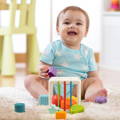Maximizing Learning: How to Use Montessori Toys Effectively
With every age comes a certain challenge. For babies, it’s to learn how to walk or talk; for toddlers, it’s how to control their emotions and embrace independence; and for preschoolers, it’s all about learning new skills.
It might not seem hard to us, but our children are constantly learning new stuff, which can be tiring and stressful from time to time. That’s why we, as parents, are responsible for guiding them through this journey. And what better way to do so than use the help of Montessori toys?

In the Montessori theory of education, children are provided with tools and toys that help them learn at their own pace. However, it’s not enough just to give them toys and let them play; it’s also important to guide them when they need assistance.
That’s why Montessori teachers and parents play a crucial role in this journey.
So, let’s see the best way to present and use Montessori toys.
Understanding Montessori Toys
Montessori toys seem simple but offer much more than traditional, mainstream ones. They promote open-ended play while also fostering independence in children through hands-on exploration.

But what’s the real magic behind the Montessori toys? - The simplicity.
Children are often mesmerized by the appeal of trendy new toys and their dazzling and flashy features. While in Montessori toys, children are more focused on what matters: playing and learning.
Using Montessori Toys the Right Way
Incorporating Montessori toys into your child's play routine is like adding a sprinkle of education to everyday activities.

Here’s the best way to use Montessori toys:
- Create a designated play area: Set up a space where Montessori toys and methods excel the most. A cozy corner or a specific playroom helps kids maintain concentration and focus while playing.
- Balancing structured and unstructured playtime: Find the sweet spot between planned activities and free play. Structured games teach specific skills, while unstructured time lets kids explore at their own pace.
- Rotate toys to maintain interest: Keep the excitement alive for hours by rotating toys your child loves. Make sure your kid is always presented with choices, but don’t overwhelm them.
- Encourage self-directed play: Montessori toys are designed for exploration, allowing children to explore and choose how they want to play with these toys. Always let your child play with the toy alone, and only help them if they ask for it or if they obviously need it.

- Allow children to choose their toys: Always encourage your little one by letting them decide which Montessori toys they want to play with. This strengthens independence and decision-making skills.
- Nurture problem-solving skills through play: Introduce toys that present challenges and create the need to think and solve problems. This encourages problem-solving and critical thinking.
- Observe and follow your child's lead: Pay attention to your child's interests and preferences. Montessori learning is about following the child's curiosity and intentions, allowing them to choose activities that capture their attention.
- Be patient and allow exploration: Montessori learning is a process that requires patience. Allow your child to explore, make mistakes, and learn at their own pace. Don’t intervene unless necessary.
How Do You Choose the Best Montessori Toys for Your Child?
To choose the best Montessori toys for your child, you need to consider your child’s developmental needs. For example, if your toddler is intrigued by the variety of colors and shapes, it’s a good idea to give them a shape-sorting puzzle with a colorful design.

Here’s what’s most important to consider when choosing Montessori toys:
2. Fine motor skills development: Choose toys that encourage hand-eye coordination and fine motor skills. Items like puzzles, stacking toys, or toys with buttons and latches are excellent for this purpose.
Montessori Toys: Our Pick
Now, let’s take a look at some of the best Montessori toys by age and see how they align with children’s general development.
Montessori Shape Blocks - Best for 1-year-olds

Children at the age of one are always exploring, trying to figure out how the world works around them. That’s where the Montessori Shape Blocks come into play. Namely, this toy focuses on hands-on exploration, which ensures the development of fine motor skills.
Here's why these blocks are a game-changer:
- Redirecting attention to learning: Montessori Shape Blocks redirect your child’s attention towards purposeful play, enhancing focus, attention, and precise hand movement.
- Great for bath time: These blocks make bath sessions easy by engaging them in catching floating shapes. This activity ensures practicing hand-eye coordination and reduces shampoo-on-the-face problems.
- No screens, only toys: Montessori Shape Blocks keep your child engaged and motivated to learn and play. This is a great way of developing a sense of order, patience, attention span, and self-discipline, all without screens and distractions.
Montessori Cooking Tools - Best for Toddlers

What if there’s a way to teach your toddler how to prepare their own meals? Actually, there is! The Montessori Cooking Tools are great when it comes to turning your kitchen into a classroom for little chefs. Obviously, your supervision is always required.
Here’s a couple of benefits this toy offers:
- Real cooking tools for real learning: These aren't just play utensils; they are real cooking tools designed to help your child prepare simple dishes. From putting jam on bread to shaping baking dough, this set is your ticket to bonding over secret family recipes.
- Safety first: These tools are intentionally not sharp and can only cut through the softest of groceries, like bananas. With the included gloves, your child's safety will be at the highest level.
- Development in mind: You’ll shortly see that your child's fine motor skills and hand-eye coordination are getting better and better after each slice. This toy teaches practical life skills and promotes independence and confidence.
Montessori Magic Reusable Book - Best for Preschoolers

If your child is always looking to draw, paint, or scrabble something on paper, then the Montessori Magic Reusable Book is the right toy! This toy is a canvas of endless possibilities as your child’s imagination is set free.
Let’s see some of the best things that this toy offers:
- Education through exploration: With a variety of interesting themes, your child will learn about dinosaurs, ocean life, rockets, vehicles, and numbers while coloring countless times.
- School prep: Prepare your kids for school without them even knowing it. Coloring books have long been favorites when it comes to teaching colors, shapes, numbers, and letters.
- Creativity: This toy is perfect when it comes to improving imagination and fostering independence while also focusing on creativity, attention span, and self-discipline.
Conclusion:
With everything we said so far, it’s clear that the Montessori approach and principles of learning are beneficial for children of all ages. And, with the right kind of toys, our kids are going to have a blast while learning through play.
So, don’t hesitate to get your child their new favorite toy. Surprise them with a coloring book or a cooking set that will keep them occupied for hours.
Free Delivery
Over $80
Easy Returns
No questions asked
Unbeatable Warranty
1-year ++ warranty
- Secure CheckoutWorld’s most secure payment method




